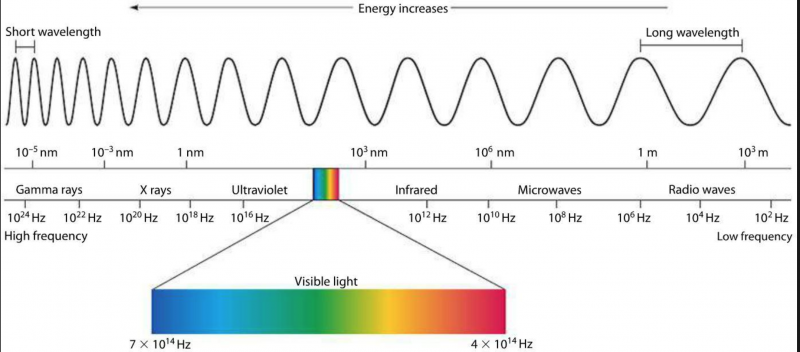Light lab
Greetings,
- The light lab is one of my favorite labs to do...mainly because i start the lab off with a series of neat demonstrations about light. Why are we talking about light? As noted in this mornings lecture material, classical mechanics (physics) does an awesome job of explaining many of the day to day observations related to things (solid objects) moving around in our world...including planets. A second, and separate field of physics deals with light or electromagnetic (EM) radiation.
- - classical mechanics (CM) treats objects as particles (solid objects). From CM we get mass, position, speed, acceleration, momentum, gravity, etc.
- - optics treats "light" as waves. From optics we get wavelength (λ), frequency (ν), and speed of light (c)...diffraction, prisms, etc.
When CM tried to explain atoms and molecules as "particles" like baseballs, it did not do a very good job. I made an analogy in this morning's lecture notes about screwdrivers...consider re-reading if you missed it. It turns out that in order to explain electrons we do not describe them as particles (yes they can behave like particles sometimes) but we describe them as waves. Yes, this is a bit confusing, but welcome to the quantum world!
So for this reason we start our exploration of the structure of an atom with the study of light and wave properties.
The Electromagnetic Spectrum
A figure similar to the above is shown in your text in Figure 7.4. Depending on the wavelength/frequency of the electromagnetic waves...we will just call this "light" from here out...different names are given to certain regions. For example, we are all familiar with the visible spectrum of light. As humans we evolved in the presence of our sun and hence our eyes are "tuned" to the visible spectrum generated by the sun. Although we will not be able to do it in this virtual lab, we have a way of displaying in the lab the full range of visible wavelengths for you to observe. I (Brad) am personally deficient in some of my color sensing "cones" in my eyes and hence the intensity of wavelengths above 650 nm are quite dim to me...i don't like it when speakers use red laser points...i like green!
- In the figure please not the following:
- 1) In the figure above, the visible spectrum is labeled with the frequency (7e14 Hz --> 4e14 Hz; by the way a "Hertz" = 1/s)...but in your text, the visible spectrum is labeled with the wavelength like this:
- If you recall this mornings lecture, the following relationship exists: ν = c/λ, so
- 7e14 1/s = 3e8 m/s * λ...solving for λ --> 0.000000429 m or 429 nm. (recall c = speed of light = 3e8 m/s)
- this relationship can be rearranged to: λ = c/ν
- If you recall this mornings lecture, the following relationship exists: ν = c/λ, so
Now it is your turn
Problem 1
Convert the following frequencies to wavelengths:
| Frequency (1/s) | Wavelength (m) | Wavelength (nm) |
| 8.00e14 | ||
| 7.00e14 | ||
| 6.00e14 | ||
| 5.00e14 | ||
| 4.00e14 |
Problem 2
Convert the following wavelengths to frequencies:
| Wavelength (nm) | Wavelength (m) | Frequency (1/s) |
| 760 | ||
| 610 | ||
| 510 | ||
| 439 | ||
| 385 |
Problem 3
Complete the following table (no answers given):
| Frequency (1/s) | Wavelength (m) | Wavelength (nm) |
| 7.70E+14 | ||
| 4.55E-07 | ||
| 517 | ||
| 4.70E+14 | 638 | |
| 7.69E-07 | 769 |
Energy of Light
In section 7.2 we discussed how Plank made a connection between the energy (E) of light and the wavelength/frequency. This was a new concept that had not been previously developed and resulted from the need to understand electrons, atoms, and molecules. This relationship was E = h ν = h c/λ, where h is Plank's constant = 6.626e-34 J s.
As you can see in the electromagnetic spectrum figure above:
- the shorter the wavelength the higher the energy.
- the higher the frequency the higher the energy.
- lower energy means longer wavelengths or lower frequency.
- higher energy means shorter wavelengths or higher frequency.
- Radio waves are low energy, long wavelength, and low frequency.
- X-ray waves are high energy, short wavelength, and high frequency.
- Infrared (IR) waves (heat) are lower energy than visible waves.
- Ultraviolet (UV) waves are higher energy than visible waves.
- Note: UV waves are emitted from the sun and are damaging to our skin. So as humans evolved on earth, the greater the exposure to sunlight (UV) the more pigments we expressed in our skin in order to block the UV wave from causing damage.
Problem 4
Complete the following table (no answers given)
| Frequency (1/s) | Wavelength (m) | Wavelength (nm) | Energy (J) |
| 7.60E+14 | 3.95E-07 | 395 | 5.04E-19 |
| 6.70E+14 | |||
| 508 | |||
| 6.52E-07 | |||
| 2.58E-19 |
END of Lab (you do not need to turn anything in...there will be a WA to check your work later...)

